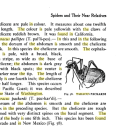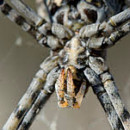Written by Madame Parsley
The samples were crisp and brittle when they got to us.
Three spiders; two of the same species and one smaller and reddish.
Many insect are identified by their mouth parts, genitalia, pedipalps, spinnerets, and other body shapes which can be tricky and get as technical as flower or plant ID with botanical terms.
There was a phone number and name.
This info was added in a phone conversation with client:
The sample was found in a debris pile of construction material that had been sitting for maybe as long as a decade. There was a lot old building material as well as some “organic matter.” The client assumption was that:
-all three specimens were the same species
-they were not from around here but introduced as he had done extensive internet research and could not find a match
-they were unusual for spiders in that they were slow moving and had pincers with claws that they used for hunting as well as their 8 legs
-they might be scorpions
I listened and looked at both spiders and scorpions and learned that scorpion are arachnids.
-There is a species of spider called the pseudoscorpion.
-There is a species of spider called an ant mimic because it uses 6 legs to travel, relaxing the insects in travels among and then grabs its prey with it other 2 legs. What a strategy for success!
-there are few poisonous spiders here. the black widow is found in he San Juans, the hobo is equivocal as to whether or not it is poisonous.
-We have a giant house spider that looks much like a hobo.
-All spider help us by eating other insects and should let to do their jobs.
-They do look creepy esp. under a microscope.
– Oregon Stare and Washington gov’t have excellent information on local insects including spiders.
After a few hours of research I was about to give up when I gave it one more try, the result was an exact ID !
Thanks for the spider info via phone this afternoon. Before sending the black ones into the lab at WSU or contacting my entomologist friend, I thought I would give it one more try.
Boy, did I ever hit pay dirt. The black specimens are now in many little pieces as I examined them thoroughly and picked them apart. Your black specimens, while unusual in appearance are spiders. They are not scorpions nor pseudoscorpions. They are not from afar. I am sorry. That would have been fun.
See the links below:
https://en.wikipedia.org/wiki/
The pincers are held vertically on the specimen and singly jointed as well as having a spinneret on their abdomens.
Here it is:
I then found this book and did a little screen capture bit. The Spider Book- A Manual for the Study of Spiders and Their Near Relatives by John Henry Comstock Professor of Entomology Cornell 1912 One can download the book as an ebook free. I guess the copywite has run out.
The reddish specimen is another type spider . The thingys coming out by the mouth on the reddish one are called pedipalps . I did not go any further to ID that species after seeing that it appeared to follow all the usual spider characteristics. Check the pedipalps out below from Wikipedia. They are amazing !
Spider pedipalps
Pedipalps of spiders have the same segmentation as the legs, but the tarsus is undivided, and the pretarsus has no lateral claws. In sexually mature male spiders, the final segment of the pedipalp, the tarsus, develops into a complicated structure (sometimes called the palpal organ or bulb) that is used to transfer sperm to the female seminal receptacles during mating. The details of this structure vary considerably between different groups of spiders and are useful for identifying species.[1][2]
Pedipalps are sensitive chemical detectors and function as taste and smell organs, supplementing those on the legs.
I appreciate all the information that you were able to give me. Many people are not as observant as you and your observations really helped me get to the right place. I am especially grateful for the info that they are slow moving which is not a regular spider behaviour. It was the one last clue that matched the info on the web that gave me the ability to think, this is it . You asked about how to go about researching and finding the answer. Some of it is the training we receive, some of it is luck, some of it is knowing where to look, some of it is finding credible sources on the web, some of it is experience .We always check and double check our work with as many source as we can find until we are confident. If we cannot get resolution, we say “I don’t know” and “I will find out.” We are fortunate to have Washington State University to help us with further and deeper work.
I will watch spiders with renewed interest from now on having learned for you inquiry. Thanks for the question. Do you want your little container back or the spider bits?




